
Parcoblatta fulvescens, the fulvous wood cockroach, is a species of cockroach endemic to the United States and possibly Canada that measures around 13 mm (0.5 in) long.

Curetis bulis, the bright sunbeam, is a species of butterfly belonging to the lycaenid family. It is found in Asia.
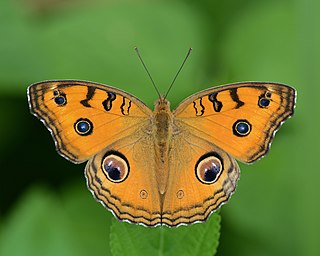
Junonia almana, the peacock pansy, is a species of nymphalid butterfly found in Cambodia and South Asia. It exists in two distinct adult forms, which differ chiefly in the patterns on the underside of the wings; the dry-season form has few markings, while the wet-season form has additional eyespots and lines. It is listed as Least Concern in the IUCN Red List.
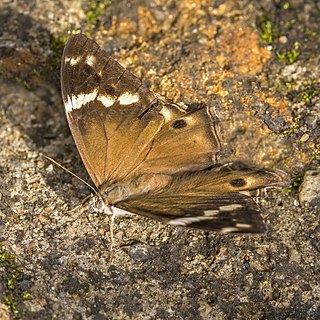
Lethe drypetis, the Tamil treebrown, is a species of Satyrinae butterfly found in south India and Sri Lanka.

Vindula erota, the common cruiser, is a species of nymphalid butterfly found in forested areas of tropical South Asia and Southeast Asia.
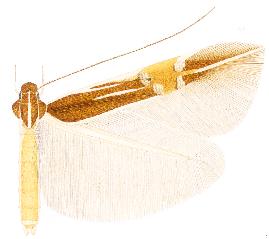
Cosmopterix erinome is a moth of the family Cosmopterigidae. It is known from the United States.

Cosmopterix galapagosensis is a moth of the family Cosmopterigidae. It is known from the Galapagos Islands.

Cosmopterix nishidai is a moth of the family Cosmopterigidae. It is known from Costa Rica.
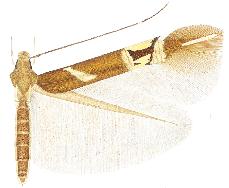
Cosmopterix nitens is a moth of the family Cosmopterigidae. It is known from the United States, where it is found from coastal South Carolina to south-western Texas. It is also established in Michigan.

Cosmopterix orthosie is a moth of the family Cosmopterigidae. It is known from Minas Gerais, Brazil.

Cariblatta lutea is a small species of cockroach native to the United States and other countries, measuring usually around 7 millimeters long as an adult and under 2 millimeters from head tip to abdomen tip at the 1st instar or hatchling. It consists of two subspecies, the small yellow cockroach, and the least yellow cockroach.

Parcoblatta bolliana, Boll's wood cockroach or Boll's wood roach, is a small species of wood cockroach native to the United States, measuring around 11 mm (0.43 in) long.

Parcoblatta uhleriana, the Uhler's wood cockroach, is a species of Parcoblatta native to the United States and Canada. It is a forest species also found in disturbed and urban environments. The male of the species flies freely, while the female does not fly.

Parcoblatta lata, the broad wood cockroach, is a species of wood cockroach native to the United States. It is one of the largest species of wood cockroaches.
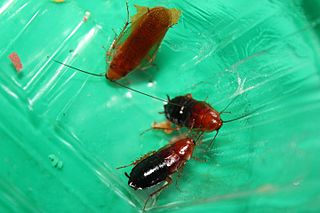
Parcoblatta caudelli, Caudell's wood cockroach or Caudell's wood roach, is a species of cockroach native to the United States.
Parcoblatta desertae, the desert wood cockroach or desert cockroach, is a species of Parcoblatta endemic to the United States state of Texas.

Parcoblatta americana, the western wood cockroach, is a species of wood cockroach that occurs in Mexico and the western United States.
Parcoblatta notha, the Arizona wood cockroach, is a species of wood cockroach that occurs only in the southwestern US state of Arizona. It is a relatively large, light colored member of the 12-species wood cockroach genus Parcoblatta. The male has fully developed wings and is able to fly, while the female wings are around half as long and does not fly.
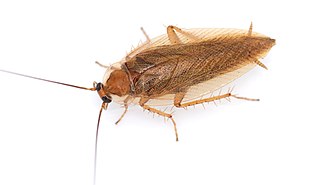
Ectobius vittiventris, the amber wood cockroach or amber forest cockroach, is a species belonging to the order Blattodea and is a type of wood cockroach originally from southern Europe. It is completely harmless to humans and is not a storage pest, as it only feeds on decomposing plant material and perishes within a few days in human dwellings due to a lack of food. Its original range was south of the Alps, but is now permanently established north of the Alps and in southern Germany.

Sphiximorpha willistoni, or Williston's wasp fly, is a rare species of syrphid fly found in eastern North America. It is a strong wasp mimic. Hoverflies can remain nearly motionless in flight. The adults are also known as flower flies for they are commonly found on flowers, from which they get both energy-giving nectar and protein-rich pollen. Larvae in this genus are found in sap runs of trees.













